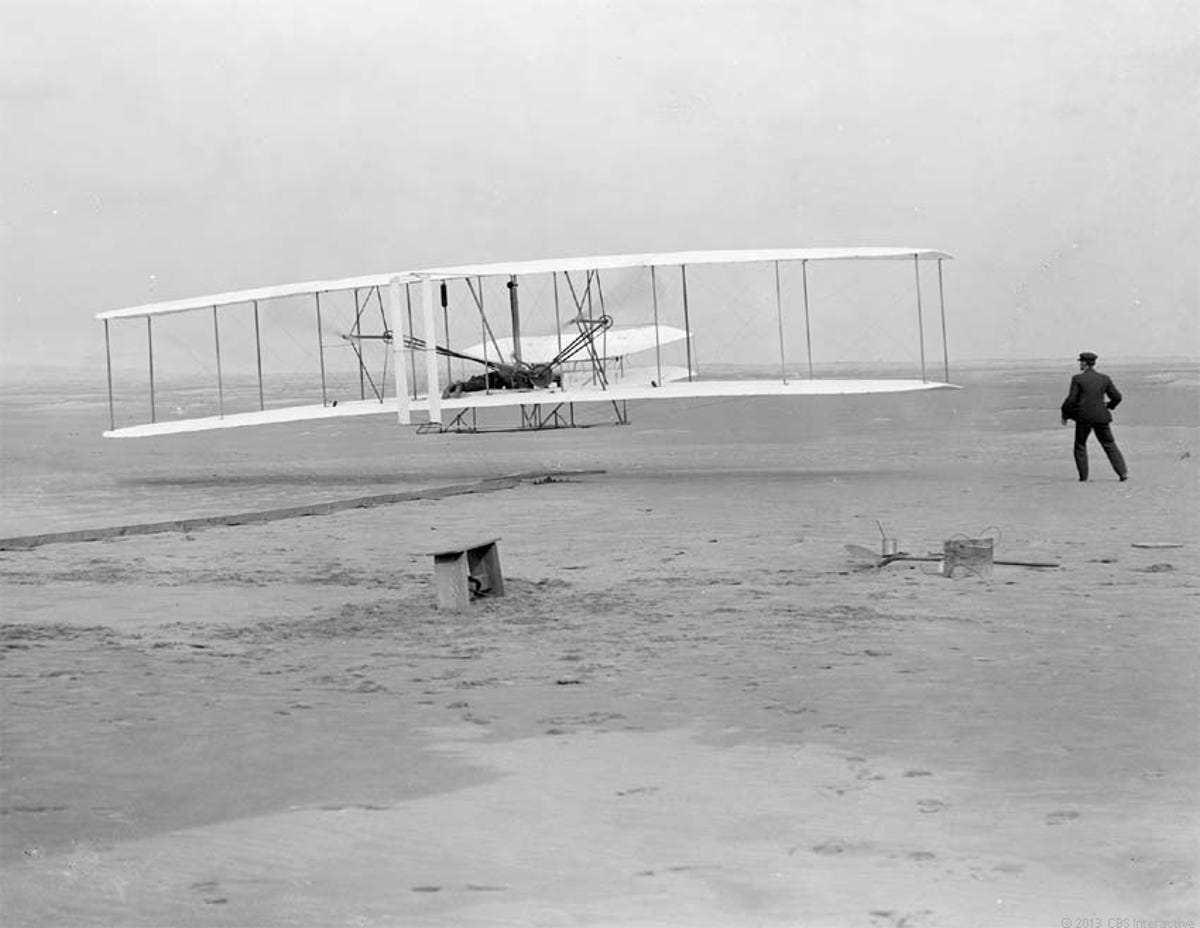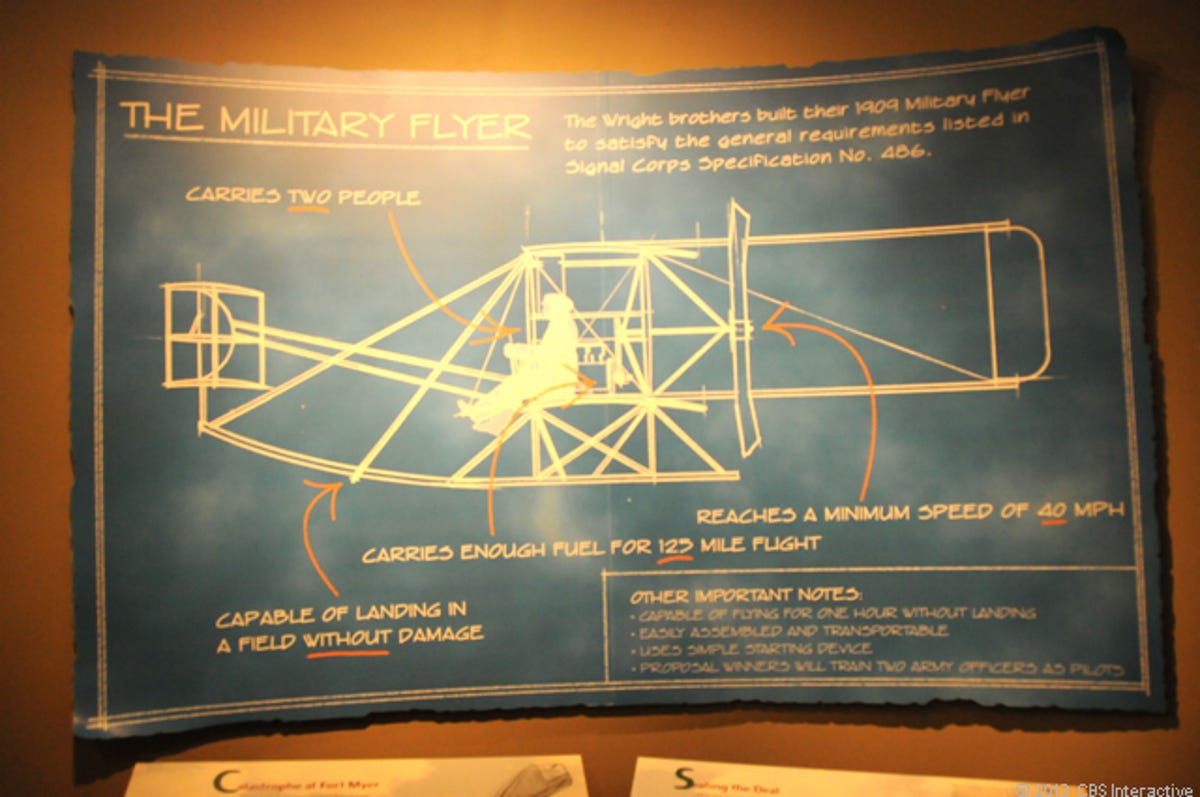How the Wright brothers won the race to invent the airplane (pictures)
On Road Trip 2013, visiting Dayton, Ohio, where the Wrights lived and worked, CNET's Daniel Terdiman couldn't avoid the influence of the invention of the airplane.

First flight
DAYTON, Ohio--There's no escaping the Wright brothers.
Here in this southwestern Ohio city, the influence of the Wrights, the two brothers who in 1903 made the first-ever powered, manned flight, is everywhere. There's Wright State University. There's Wright-Patterson Air Force Base. There's the Dayton-Wright Brothers Airport. And the entire area is encompassed in the National Aviation Heritage Area.
A lifelong fan of airplanes and aviation, CNET's Daniel Terdiman went to the Dayton Aviation Heritage National Historical Park as part of Road Trip 2013 to learn more about the history of the Wright brothers, and their technological achievements, which some argue are the greatest in American history.
Wright Flyer
The original Wright Flyer, with which the Wright brothers made the world's first airplane flight on December 17, 1903, is permanently housed at the Smithsonian's Air & Space Museum in Washington, D.C. The Dayton Aviation Heritage National Historic Park has a replica of the aircraft.
While the Wrights were competing with a number of other would-be inventors of the airplane, the brothers were the first to come up with the eventual winning combination of innovations -- figuring out how to achieve lift and drag; how to deliver thrust to the machine; and most important, the use of three-axis control. Until that point, most people trying to get a powered aircraft to fly had only been thinking about up/down and left/right. But as bicycle makers, the Wrights knew there was another axis, and knew that rolling the plane was key to maintaining flight.
Although the Wrights are generally acknowledged as the inventors of the airplane, there is another inventor whose work has been gaining supporters, especially in Connecticut. That man, Gustave Whitehead, is said to have first flown an airplane in 1901.
Wright Flyer III
Although the original Wright Flyer gets most of the ink -- and why not, given that it made the first-ever manned, powered flight, which was captured in a perfect photograph -- some would say that the brothers' Wright Flyer III, which they used to perfect their airplane design, is more important in the annals of aviation.
Today, the plane, which on October 5, 1905, made a 24-mile, 39-minute flight -- more than all other flights made by anyone up to that time combined -- is permanently housed in the Wright brothers exhibit at the Carillon Historical Park Museum.
The main reason this plane may be more important to aviation history is that, because the Wrights used it to demonstrate that they'd solved most of the technical problems they'd been working on for years, they were now able to market the machine. And that meant, primarily, that they could seek out a contract with the U.S. Army. This formed the basis of the Wright Company, their airplane business, which made them rich, unlike their previous printing and bicycle businesses.
Pilot
As with the Wright Flyer I, the pilot of the Wright Flyer III lay down horizontally at the front of the aircraft and flew alone. But before it would sign a deal with the brothers, the U.S. Army insisted that the airplane be able to take a passenger, and that both pilot and passenger sit upright.

Military diagram
Based on the Army's requirements, this was the Wrights' new design for their airplane, the Wright Military Flyer.
First flight camera
To some, this camera may be one of the most iconic in history, given that it was used to photograph the Wrights' first flight at Kitty Hawk, N.C. The Wrights turned to local photographer John T. Daniels to document the flight. Daniels was fortunate to click the shutter with the Wright Flyer in the center of the frame, and with Wilbur Wright running alongside as his brother Orville flew for 120 feet at an airspeed of about 34 miles an hour.
The Wrights had set the camera up to point at the spot at which the plane would go aloft. It was in focus, and all Daniels had to do was click the shutter. But in the excitement of the moment, Daniels couldn't remember if he'd managed to do his job. Fortunately for history, he did.
1911 test engine
This is a 35-horsepower test engine built for the Wrights in 1911 by their mechanic, Charles Taylor, who had built the 170-pound, 12-horsepower gas engine that the Wrights used to power the Wright Flyer I for the December 17, 1903, first flight.
Wind tunnel
Another one of the Wrights' innovations in 1901 was using a wind tunnel to figure out the effectiveness of wind foils of a number of shapes. They used the wind tunnel to confirm results they had made earlier including one testing a rotating airfoil they mounted on one of their own bicycles.
Wind tunnel wind foil
As part of their experiments, a wind foil like this one would be placed inside the wind tunnel and the Wrights would record the results.
Bicycle airfoil
Before using the wind tunnel, the Wrights had come up with an ingenious way to test various airfoils by mounting them on the handlebars of one of their bicycles and recording the results as they rode the bike.
Huffman catapult
Although the Wrights made their first flight in secrecy at Kitty Hawk, N.C., as they progressed in perfecting the airplane, they needed to be able to do much more frequent testing back home in Dayton as well.
As a result, they chose a cow pasture in a flood plain on the edge of town now known as the Huffman Prairie Flying Field.
There, the Wrights conducted countless tests of their various planes, and even set up a flying school there. It was here that the Wrights conducted their 39-minute flight that convinced them they were ready to patent their work and get their airplane business of the ground.
Although the Wrights had long experience with bicycles, they somehow hadn't originally come up with the idea of putting wheels on their planes. That meant that in order to get the planes in the air, they needed to catapult them. This is a replica of the catapult they installed at Huffman Prairie. The plane would be thrust down the rail and it would vault into the air when it hit the right speed.
Hangar
This is a replica of the hangar the Wrights used to store their equipment at Huffman Prairie Flying Field.
Patent
While there were numerous challenges to their patent for what they called their "flying machine," the Wrights maintained their rights in large part because their patent attorney, Harry Toulmin, wrote a very broad application that included the concept of three-axis flying. Though the patent was granted, there were many who didn't accept the Wrights' claim to having invented the airplane, and even the Smithsonian Institute, which has been a big supporter of the Wright brothers story, didn't acknowledge their claim until 1942.
This is a replica of their original patent.
Wright Cycle
Before inventing the airplane, the Wright brothers had run two other businesses, one a print shop, and the other a bicycle-making company.
They sold two types of bikes, the Van Cleve, and the St. Claire.
Wright Cycle
There are very few original Wright brothers bicycles left in existence. But the Dayton Aviation Heritage National Historic Park has one, this St. Claire.
The Wrights were likely able to take years to perfect their airplane design not because of the success of their bicycle business, but because their father had money and the brothers lived at home, meaning their costs were far lower than would have otherwise been the case.
Model gliders
On display at the Dayton Aviation Heritage National Historic Park are these three models of the Wrights' early gliders.
The one of the bottom is a model of the Wrights' 1900 glider, which had a wing span of 17 feet. They made their first flight using this aircraft, which was made from wood and cotton sateen fabric. The glider did prove that their basic design was air-worthy, but they had difficulty getting it aloft with the weight of a pilot in normal winds. The glider weighed 190 pounds.
The middle aircraft is their 1901 glider, which had a wing span of 22 feet and weighed 98 pounds. They built this hoping that they had solved the lift problems with a forward elevator meant to control pitch. However, it was still difficult to control, despite the fact that the Wrights used this glider to break a number of distance records.
The 1902 glider, on top, had a wing span of 32 feet, 1 inch, and weighed 112 pounds. They installed a movable single rudder to handle yaw problems, and the glider became the first aircraft to be totally under the pilot's command, according to the Dayton Aviation Heritage National Historic Park. They made more than 250 glides with the aircraft, some nearly 600 feet.
Broken engine part
This is a broken piece of the mounting foot from the Wright Flyer I. On December 17, 1903, they made the first-ever airplane flight at Kitty Hawk, and over the course of the day, they made three more flights, the longest traveling 852 feet. A gust of wind subsequently flipped the plane, heavily damaging it.
Harpers cover
In order to gin up potential investors, the Wrights flew the Wright Flyer III around New York, which Harpers magazine photographed and put on its October 9, 1909, cover.
Wright Company factory building
The first two buildings on the left are the original Wright Company factory. Over the years, the buildings were used in auto parts manufacturing, and now, they are in the process of being decontaminated and added to the roster of locations included in the Dayton Aviation Heritage National Historic Park.
Pontoon
In order to fly a Wright Model A up the Hudson River, Wilbur Wright lashed a canoe to the bottom of the plane. This is that canoe.
Dayton replica of the Wright Flyer
Though the original Wright Flyer is in the Smithsonian's Air & Space Museum in Washington, D.C., the Dayton Aviation Heritage National Historic Park has a replica of the aircraft.
Wright house
With the riches they earned from their airplane company, the Wrights purchased this mansion atop a hill just outside Dayton.

